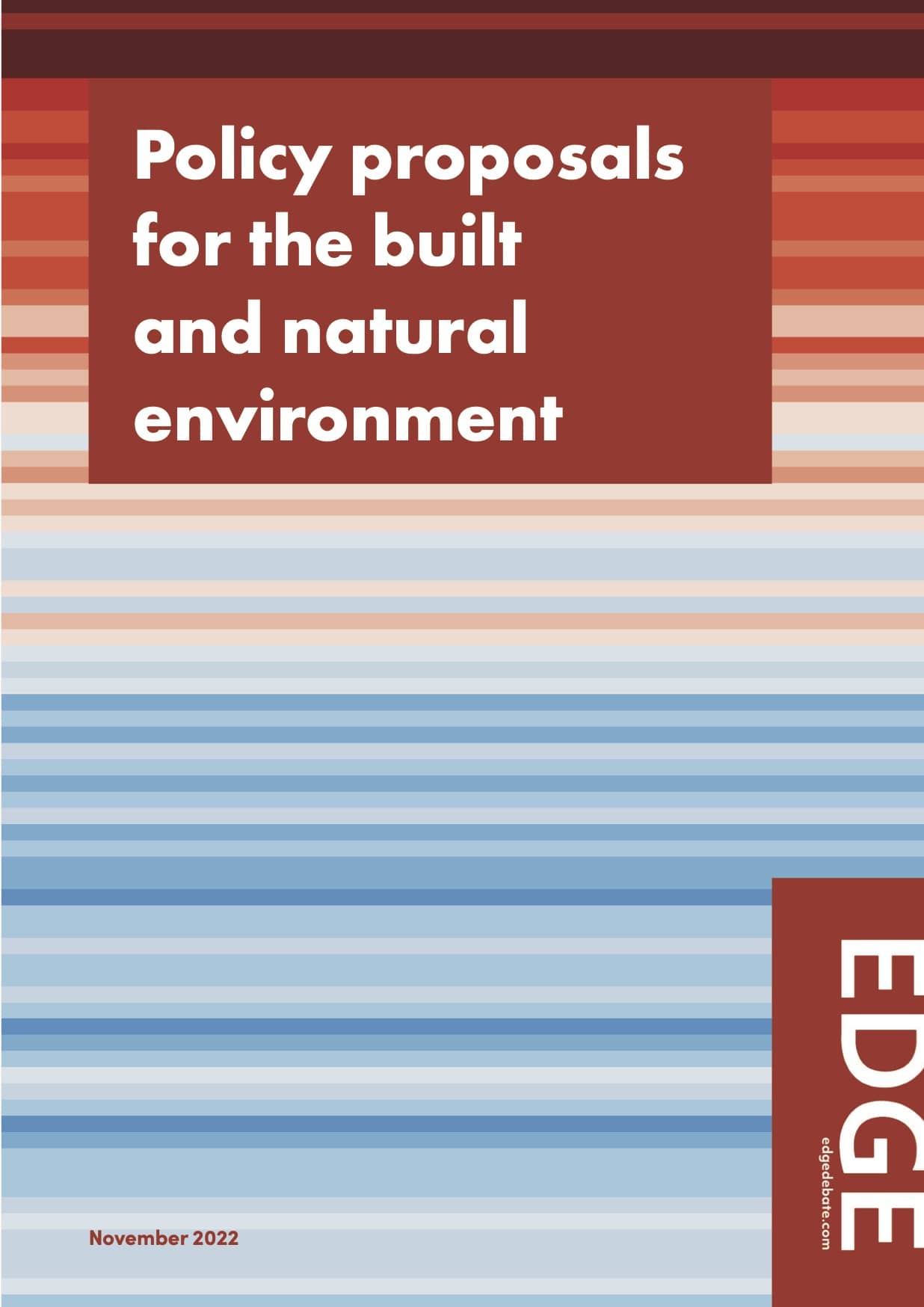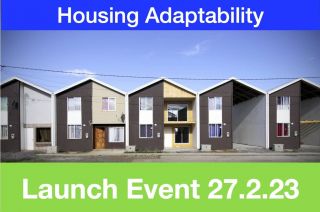
www.buildingsandcities.org/insights/news/policy-proposals-built-environment.html
Policy Proposals for the Built and Natural Environment
A wide, coordinated set of policy proposals for built environment is launched for tackling global warming and biodiversity.
The UK built and natural environment think tank, the Edge, has drawn on the widespread expertise of its members to produce a concise set of interconnected policy recommendations aimed at enabling the design, construction and property industries to deliver on their obligations in the face of the twin climate change and biodiversity emergencies. The policy proposals are an urgent Call to Action to prevent on-going environmental and social harm.
The Proposals

Organised under 8 headings, ranging from the broad to the tightly focused, each section is typically the responsibility of a different government department or part of the industry, the proposals describe how the built and natural environment sector can and must change. To succeed nearly all of the proposals need to be acted on together and with the greatest urgency. They cannot and should not be cherry picked or delayed.
The intended audience is busy, and often distracted, policy and decision makers and, in consequence, the document is written to be as accessible and straightforward to grasp as possible with each proposal usually just a single sentence. This means that the very necessary detail, deliberation, research and references required to back them up are missing and the Edge intends to publish a follow up document, with fuller information and detailed arguments for the propositions, later in 2023.
The focus is on the UK industry and government, both local and national, but the great majority of the proposals are applicable globally.
The 8 thematic sections are as follows:
1. An economy that supports the
environment
There
is an urgent need to restructure the economy to one that that actively supports
the environment, including a reform of tax structures to support good behaviour
and penalise bad. A tax on carbon and other pollutants produced by products and
services should replace Value Added Tax at a revenue neutral rate. Incentives are
also required to reward carbon reduction, biodiversity net-gain, minimising the
use of virgin resource and enabling circular economy businesses and projects.
Utility providers should be reinvented as public interest organisations charged
with driving forward the net zero carbon agenda.
2. Planning for the benefit of
society as a whole
Planning
and planning policy must be re-focused on achieving social value with
measurable and monitored objectives applied to achieving a range of core social,
economic and environmental goals. Planning policy must be required to take the
needs of future generations into consideration and should flow seamlessly into
other aspects of design and construction including building regulations, health
and safety practice and facilities management to achieve the 'golden thread'
that connects decision-making on projects throughout their life cycle.
3. Using our limited land
intelligently and productively
Using our limited land and natural resources well is critical for delivering on
social and environmental objective, whether good housing and employment or
clean air and access to open space. A coherent land use strategy that balances
conflicting requirements for the British Isles is long overdue and should help
drive a wide range of public goods including equitable and fair access, healthy
and safe environments, greater biodiversity and food, energy and energy
security.
4. Delivering essential
infrastructure and transport
The
provision of essential infrastructure and transport is required to support a
future equitable and low carbon society and economy, fairly balancing
availability and distribution of public provision, but it needs to be
configured to encourage maximum resource and energy responsibility and
accountability.
5. Building climate and
biodiversity skills and understanding
Without
clear understanding, motivation and relevant skills across all sectors of
society it will be impossible to cope adequately with the climate and
biodiversity emergencies. All stages of education from primary to tertiary must
help deliver the skills that will enable individuals and communities to
flourish in the decades ahead.
6. Measuring, declaring and
eradicating carbon emissions
The
construction and property management sectors need to routinely measure and
declare carbon emissions, en route to eliminating them. Building owners should
be required to plan for and manage an ever-shrinking carbon budget
7. Creating a resilient built and
natural environment
Climate
change and biodiversity loss are already with us and measures must be taken to
cope with and moderate their impact if cities and urban areas are to remain
liveable. These include the widespread
application of nature-based solutions and ensuring the resilience of essential
systems.
8. Design and construction acting
in the public interest
Finally, the
construction and property industries need to take responsibility for
eliminating their large (40%+) proportion of national carbon emissions. Building
passports that provide essential data and contractual performance guarantees should
become the norm.
Next steps
The document is freely available at https://edgedebate.com/s/theEdge_PolicyProposals_1122.pdf. Hard copies are also available on request via the Edge's website.
The
Edge welcomes discussion and debate on these topics and will be arranging
public sessions in the months ahead to do just that. Alternative propositions
are very welcome.
Latest Peer-Reviewed Journal Content
Acceptability of sufficiency consumption policies by Finnish households
E Nuorivaara & S Ahvenharju
Key factors for revitalising heritage buildings through adaptive reuse
É Savoie, J P Sapinski & A-M Laroche
Cooler streets for a cycleable city: assessing policy alignment
C Tang & J Bush
Understanding the embodied carbon credentials of modern methods of construction
R O'Hegarty, A McCarthy, J O'Hagan, T Thanapornpakornsin, S Raffoul & O Kinnane
The changing typology of urban apartment buildings in Aurinkolahti
S Meriläinen & A Tervo
Embodied climate impacts in urban development: a neighbourhood case study
S Sjökvist, N Francart, M Balouktsi & H Birgisdottir
Environmental effects of urban wind energy harvesting: a review
I Tsionas, M laguno-Munitxa & A Stephan
Office environment and employee differences by company health management certification
S Arata, M Sugiuchi, T Ikaga, Y Shiraishi, T Hayashi, S Ando & S Kawakubo
Spatiotemporal evaluation of embodied carbon in urban residential development
I Talvitie, A Amiri & S Junnila
Energy sufficiency in buildings and cities: current research, future directions [editorial]
M Sahakian, T Fawcett & S Darby
Sufficiency, consumption patterns and limits: a survey of French households
J Bouillet & C Grandclément
Health inequalities and indoor environments: research challenges and priorities [editorial]
M Ucci & A Mavrogianni
Operationalising energy sufficiency for low-carbon built environments in urbanising India
A B Lall & G Sethi
Promoting practices of sufficiency: reprogramming resource-intensive material arrangements
T H Christensen, L K Aagaard, A K Juvik, C Samson & K Gram-Hanssen
Culture change in the UK construction industry: an anthropological perspective
I Tellam
Are people willing to share living space? Household preferences in Finland
E Ruokamo, E Kylkilahti, M Lettenmeier & A Toppinen
Towards urban LCA: examining densification alternatives for a residential neighbourhood
M Moisio, E Salmio, T Kaasalainen, S Huuhka, A Räsänen, J Lahdensivu, M Leppänen & P Kuula
A population-level framework to estimate unequal exposure to indoor heat and air pollution
R Cole, C H Simpson, L Ferguson, P Symonds, J Taylor, C Heaviside, P Murage, H L Macintyre, S Hajat, A Mavrogianni & M Davies
Finnish glazed balconies: residents' experience, wellbeing and use
L Jegard, R Castaño-Rosa, S Kilpeläinen & S Pelsmakers
Modelling Nigerian residential dwellings: bottom-up approach and scenario analysis
C C Nwagwu, S Akin & E G Hertwich
Mapping municipal land policies: applications of flexible zoning for densification
V Götze, J-D Gerber & M Jehling
Energy sufficiency and recognition justice: a study of household consumption
A Guilbert
Linking housing, socio-demographic, environmental and mental health data at scale
P Symonds, C H Simpson, G Petrou, L Ferguson, A Mavrogianni & M Davies
Measuring health inequities due to housing characteristics
K Govertsen & M Kane
Provide or prevent? Exploring sufficiency imaginaries within Danish systems of provision
L K Aagaard & T H Christensen
Imagining sufficiency through collective changes as satisfiers
O Moynat & M Sahakian
US urban land-use reform: a strategy for energy sufficiency
Z M Subin, J Lombardi, R Muralidharan, J Korn, J Malik, T Pullen, M Wei & T Hong
Mapping supply chains for energy retrofit
F Wade & Y Han
Operationalising building-related energy sufficiency measures in SMEs
I Fouiteh, J D Cabrera Santelices, A Susini & M K Patel
Promoting neighbourhood sharing: infrastructures of convenience and community
A Huber, H Heinrichs & M Jaeger-Erben
New insights into thermal comfort sufficiency in dwellings
G van Moeseke, D de Grave, A Anciaux, J Sobczak & G Wallenborn
'Rightsize': a housing design game for spatial and energy sufficiency
P Graham, P Nourian, E Warwick & M Gath-Morad
Implementing housing policies for a sufficient lifestyle
M Bagheri, L Roth, L Siebke, C Rohde & H-J Linke
The jobs of climate adaptation
T Denham, L Rickards & O Ajulo
Structural barriers to sufficiency: the contribution of research on elites
M Koch, K Emilsson, J Lee & H Johansson
Disrupting the imaginaries of urban action to deliver just adaptation [editorial]
V Castán-Broto, M Olazabal & G Ziervogel
Nature for resilience reconfigured: global- to-local translation of frames in Africa
K Rochell, H Bulkeley & H Runhaar
How hegemonic discourses of sustainability influence urban climate action
V Castán Broto, L Westman & P Huang
Fabric first: is it still the right approach?
N Eyre, T Fawcett, M Topouzi, G Killip, T Oreszczyn, K Jenkinson & J Rosenow
Social value of the built environment [editorial]
F Samuel & K Watson
Understanding demolition [editorial]
S Huuhka
Data politics in the built environment [editorial]
A Karvonen & T Hargreaves



Latest Commentaries
Decolonising Cities: The Role of Street Naming
During colonialisation, street names were drawn from historical and societal contexts of the colonisers. Street nomenclature deployed by colonial administrators has a role in legitimising historical narratives and decentring local languages, cultures and heritage. Buyana Kareem examines street renaming as an important element of decolonisation.
Integrating Nature into Cities
Increasing vegetation and green and blue spaces in cities can support both climate change mitigation and adaptation goals, while also enhancing biodiversity and ecological health. Maibritt Pedersen Zari (Auckland University of Technology) explains why nature-based solutions (NbS) must be a vital part of urban planning and design.